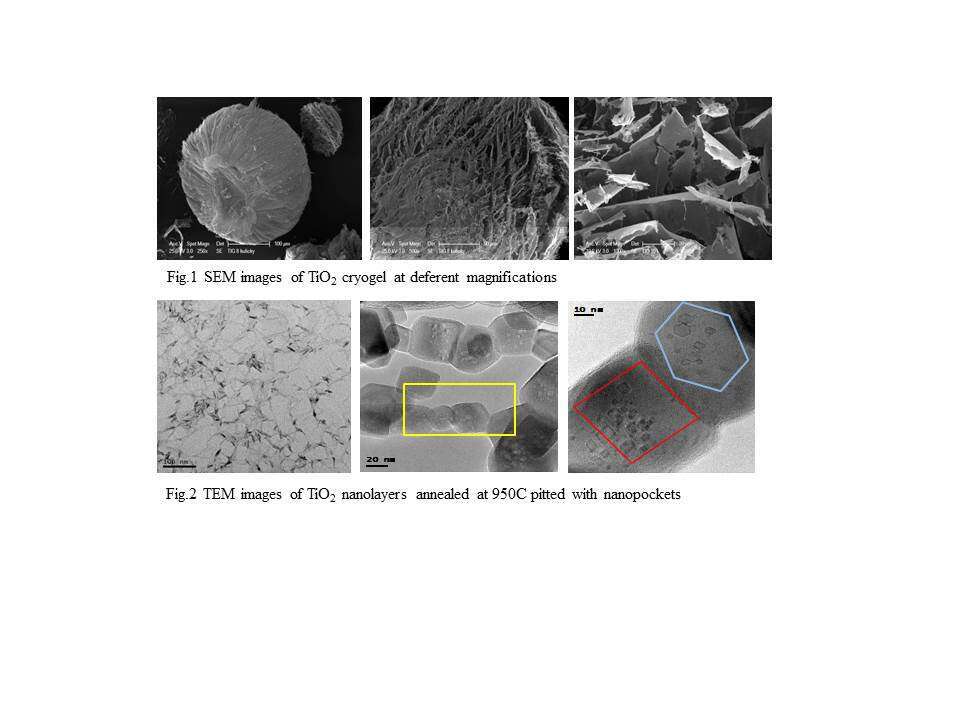Here we review the progress and advantages offered by lyophilization process as a new procedure for synthesis of aligned TiO2 cryogel templates. Titania (TiO2) 2D nanolayers with excellent photocatalytic activity and high specific surface area have been synthesized by annealing of TiO2 cryogel obtained by TiOSO4 and H2O2 as precursors lyophilized 55 hrs at temperature 210 K and pressure 5 - 10 mTorr.. Material characterization was performed using powder x-ray diffraction (XRD), transmission electron microscopy (TEM), scanning electron microscopy (SEM), nitrogen adsorption and electron paramagnetic resonance (EPR). Photocatalytic activity was determined by measuring the kinetics of degradation of Methylene Blue (MB) and 4-chlorophenol (4CP). The formation of hydroxyl radical spin adducts was observed by EPR.
The spherical morphology of as-obtained TiO2 cryogel within the layered structure is shown in Fig 1 a. The multilayered banded structure indicates growth of the spheroidal particle. The growth process occurs within the droplets of confined volume, and involves the 3D radial organization of leafs, build up inside the spheroids via stacked Ti-O sheets held together by weak van der Waals forces (Figs. 1b and 1c).
TEM image of TiO2 dense cryogel TiO2 network is shown in Fig.2a. Hierarchal morphologies of nanopockets assembled onto the surface of TiO2 layers start to appear at a temperature of more than 650°C and strongly influenced by polymorph TiO2 evolution competing reaction. The controllable lyophilization process involves a significant topotactic relationship between the as-synthesized TiO2 nanolayers and the desired nanopockets. This relationship suggests that the formation of nanopockets is an extensive spontaneous self-assembled process due to freezing and melting behavior of pore ice and pore water leading to creation of large cavities of 7-10 nm nanopocket-like pores. The nanopockets could be considered as nanounities with well defined crystallographic orientation with respect to the original anatase/rutile TiO2 structure. The HRTEM study shown collecting of hierarchical ordered square and hexagonal nanopockets onto anatase (Fig. 2 b) and ritile (Fig.2 c) layers, respectively.
Kinetic of degradation of MB and 4CP provides evidence regarding the potential relevance of TiO2 layers pitted with nanopockets in the functional properties of the resulting TiO2 nanostructures and its application as photocatalyts in degradation of environmental pollutants. The activity increased with increasing annealing temperature in order 500°C < DegussaP25 < 600°C < 850–950°C. Results of measurement of formation of •OH radicals by EPR also confirmed the unusually high activity of our materials. In comparison with the Degussa P25, the sample annealed at 950°C showed significantly higher production of •OH radicals. We could suggest that nanopocket-rich surface of TiO2 layers might be responsible for generation of hydroxylated species localized in molecular – sized cavities. On the other hand one can expect a strain-induced domain structure in TiO2 framework due to oxygen vacancy ordering that could be affected the kinetics of degradation of MB and 4CP.


